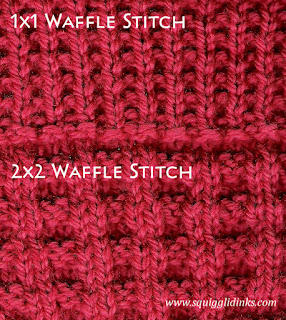Once you’ve mastered the knit and purl stitches, you can knit just about anything. Here are a few basic stitch patterns–they’re great for scarves or blankets if you want to stick to items that don’t require any shaping, or you may see them as part of more complex patterns. Give them a try!
Note: If you’re new to reading patterns, k stands for knit and p stands for purl. So if a pattern says k1, p1, it means knit 1, purl 1.
Garter Stitch
- Works with any number of stitches
- How it’s done: Knit every stitch in every row
- Abbreviated st st in most patterns
- Works with any number of stitches
- How it’s done:
- Row 1: knit all stitches
- Row 2: purl all stitches
- Repeat these two rows as desired.
- Abbreviated rev st st in most patterns
- Works with any number of stitches
- This is (as the name implies) simply the reverse of the stockinette stitch. The Wrong Side (WS, or back) of the stockinette stitch is the reverse stockinette stitch, and vice versa.
- How it’s done:
- Row 1: purl all stitches
- Row 2: knit all stitches
- Repeat these two rows as desired.
- Works with even numbers of stitches
- How it’s done:
- Row 1: k1, p1, repeat to the end of the row
- Row 2: p1, k1, repeat to the end of the row
- Repeat these two rows as desired.
- Works with even numbers of stitches
- How it’s done:
- Rows 1 & 2: k1, p1, repeat to the end of the row
- Rows 3 & 4: p1, k1, repeat to the end of the row
- Repeat these four rows as desired.
Ribbing can be done in an extremely wide variety of sizes. My 2 samples are:
- Works on an even number of stitches
- How it’s done:
- Every row: k1, p1, repeat to the end of the row
- Works on a multiple of 4 stitches (i.e. could be done easily on 16 or 20 stitches, but not so well on 18)
- How it’s done:
- Every row: k2, p2, repeat to the end of the row
You could easily do ribs in any other size too. (Just add the number of knit stitches to the number of purl stitches to find out what number you’ll need a multiple of. For instance, to do k3, p3 ribs, you’d want a multiple of 6 stitches.)
Waffle Stitch
There are all sorts of waffle stitch varieties, but these are two of my favorites.1×1 Waffle
- Works with an even number of stitches
- How it’s done:
- Row 1: k1, p1, repeat to the end of the row
- Row 2: purl every stitch
- Repeat these two rows as desired.
2×2 Waffle
- Works with a multiple of 4 stitches
- How it’s done:
- Rows 1 & 2: k2, p2, repeat to the end of the row
- Row 3: knit all stitches
- Row 4: purl all stitches
- Repeat these four rows as desired.







